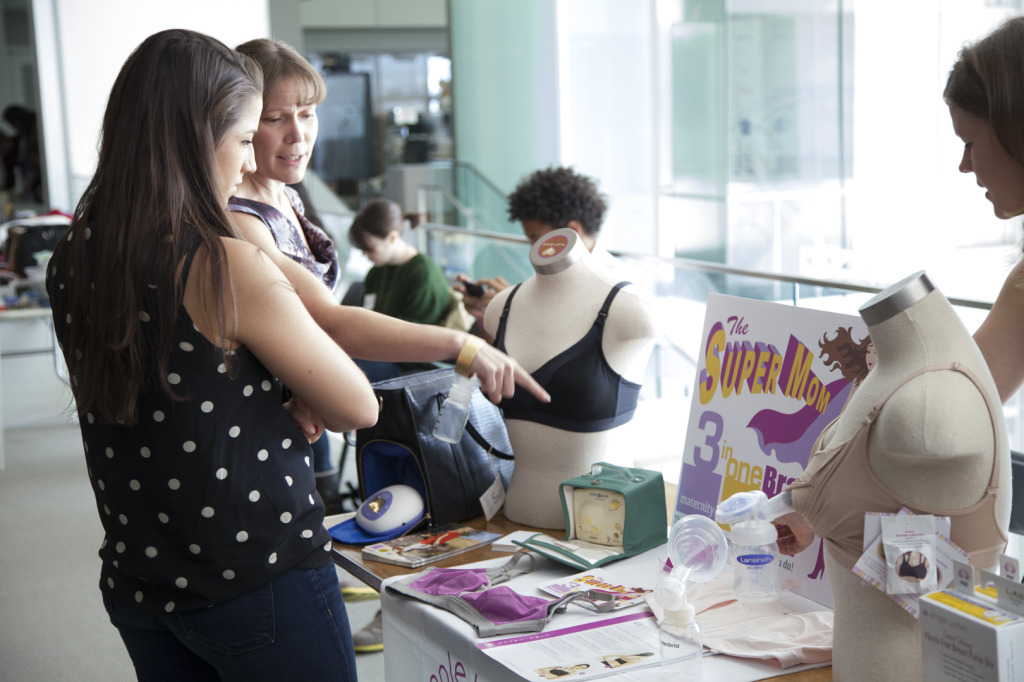One windy weekend morning last month, a large room on MIT’s campus was full of adorable infants and tables strewn with objects resembling a mad scientist’s implements. At one point, a friendly looking woman turned to a parent passing by and remarked, “I’m going to kidnap your baby.” She was kidding. Hosted by the MIT Media Lab, the Make the Breast Pump Not Suck Hackathon is a weekend-long event meant to bring together concerned parties to discuss what’s wrong with the device and think up ways to redesign it.
The breast pump could use an upgrade. If you’re familiar with the apparatuses with which dairy farmers milk cows, you’re familiar with the basic design principles underlying the modern breast pump. Most models tend to be of a bulky shape, run loud motors like miniature vacuums, and cost upward of $150. Perhaps their worst feature, from the perspective of busy parents, is that they usually consist of many small parts that are difficult and time-consuming to take apart, clean, and reassemble.
The Media Lab hosted its first breast pump hackathon in May, an event organized by MIT-affiliated software, industrial, and mechanical designers. It was inspired by a post on the New York Times’s Motherlode blog called, “Shouldn’t the Breast Pump Be as Elegant as an iPhone and as Quiet as a Prius by Now?” The hackathon’s roughly 150 attendees—women who’ve pumped, women who haven’t, supportive partners, youngish dads in plaid button-downs, new moms who seemed cool and approachable, healthcare professionals, designers, engineers, and one very enthusiastic male college student whose presence was in some ways unaccounted for—all certainly seemed to think so.
To kick off the first day of the hackathon, several lactation experts and healthcare company CEOs explained the science behind breastfeeding and the mechanical functions (and failures) of most pumps. Though several speakers contended that “breast was best” when it comes to feeding infants, their attitude lacked the righteously judgmental quality I expected to encounter at an event dealing with breastfeeding.
In fact, many speakers noted how rare it is for women to have the financial resources, spousal and workplace support, and physical stamina to allow them to continually breastfeed their children for at least two years, as the World Health Organization recommends. Deborah Theobald, the CEO of the healthcare IT company Vecna Technologies, praised pumps as the most sensible option for breastfeeding mothers who hold jobs outside the home while their children are still nursing, and as a crucial means of establishing a work/life balance for new parents. Pumping, Theobald told the assembled crowd, not only allows women to return to work, it also encourages a sort of equality between parents by giving the partner who doesn’t pump a chance to bond with their child during feedings.
Hackers then made short pitches to the crowd on how to build a better model. The almost twenty innovators came from diverse professional backgrounds but were united by the same goal: to make pumping a quieter, easier, and more discreet process. Focusing on the pumping process itself, some designs strove for “biomimicry,” rethinking the breast pump as a simulation of an infant’s natural mouth movements. One older male participant (“This idea is even better!” he said at one point, in a bid to persuade the event organizers to let him pitch twice) suggested a product with sensory enrichment to encourage milk expression. Others focused on the pumping experience; one pitcher discussed lactation architecture and suggested repurposing old phone booths into safe spaces for pumping. Participants then split up into small teams and used the ideas as jumping-off points for creating new prototypes over the weekend.
It’s not entirely clear how the breast pump ended up sucking so much. Alex Metral, an MIT research affiliate and organizer of the event, told me she sees it as “a policy issue that [comes] down to ‘why hasn’t an eye been turned towards this yet?’” A range of systemic issues—insurance companies unwilling to provide adequate equipment, a persisting societal assumption that mothers stay home with their infants, the frequent absence of lactation spaces in offices—are clearly still at play here.
But Metral dismissed my suggestion that pump inefficiency was the result of institutionalized sexism, of women traditionally being excluded from STEM fields and technology innovation, leaving them unable to contribute their own experiences. “There’s a spot of [sexism],” she said, “but it’s also the medical industry saying, ‘This is good enough.’” Most of the hackathon’s speakers and many of the team leaders pointed out that maternal health remains a low priority in the American healthcare system.
But even if that were more a function of economic and production-based factors than of sexism, it’s difficult to extract gender from the equation altogether. The devices healthcare companies bring to market clearly fall short of customers’ needs, but those manufacturers understanding the demand for the product will remain strong anyway, allowing them to continue selling something that is good enough but not the best it can be. It’s nearly impossible to conceive of this issue persisting were mothers and non-mothers less easily sorted into their respective ends of the consumption-production dynamic.
I overheard more than two conversations comparing the expanded freedom that could come with a redesigned pump with that afforded by the birth control pill. Call me a cynic, but I was surprised there was much less talk about what is, to me, the more obvious comparison: how pumps and pills are both essential to family planning, and both meagerly subsidized by the government and insurance companies.
I left the first day of the hackathon somewhat dejected; if we still have to pay twenty-five cents for a single tampon in public restrooms, how will we ever manage to provide women with free, high-quality breast pumps, to say nothing of paid parental leave? Nevertheless, the entrepreneurship, expertise, and collaborative spirit I witnessed were truly inspiring. Maybe it was the passion on display, or the simple fact that a well-attended conference on women’s issues was held at MIT (an institution, despite it’s almost-even split between male and female undergraduates, is still widely perceived as an elite, male-dominated school), but I realized something else, too: the problems plaguing the breast pump may not have been solved by having been hacked, but that’s a great place to start. Maternal health is in good hands, and that doesn’t suck.
·
 Molly Labell is a Boston-based writer who is continually on the hunt for the perfect desk.
Molly Labell is a Boston-based writer who is continually on the hunt for the perfect desk.

